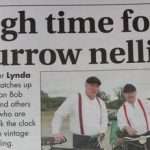The thought never occurred to me that the old black bicycles might have a name; they were just old black bicycles weren’t they? They began appearing in numbers during the summer. Around the Co Laois village of Durrow, men wearing braces to hold up their trousers, collarless shirts and flat caps rode with a leisurely elegance through the streets.
Yesterday, driving the road between Abbeyleix and Durrow a group of cyclists were making a steady progress along the road. Not a mountain bike or a set of drop handle bars in sight; each bicycle was black, sturdy and spoke of a past Ireland. The riders wore the high visibility vests that are advisable when cycling a road where traffic moves at 100 kmh; their seemed a happy camaraderie amongst them. ‘Durrow High Nelly Cycling Club’ declared the lettering on the back of the vests; so the bicycles had a name.
The High Nelly was an icon of the old Ireland. Whether on city streets or county roads, the old bike was a faithful friend to generations of Irish men and women. It took people on journeys to education and work, to sporting fixtures and musical entertainment, to religious ceremonies and romantic assignations. Church walls, shop windows, field gates, school sheds, sports ground fences, the bicycles would be seen leaning across the length and breadth of the country.
But if the bicycle widened horizons, it also set limits. Bridie in William Trevor’s Ballroom of Romance lives in a world circumscribed by how far she can pedal.
“As well as Mass on Sundays and her weekly visits to a wayside dancehall Bridie went shopping once every month, cycling to the town early on a Friday afternoon. She bought things for herself, material for a dress, knitting wool, stockings, a newspaper, and paper-backed Wild West novels for her father. She talked in the shops to some of the girls she’d been at school with, girls who had married shop-assistants or shop-keepers, or had become assistants themselves. Most of them had families of their own by now. ‘You’re lucky to be peaceful in the hills,’ they said to Bridie, ‘instead of stuck in a hole like this.’ They had a tired look, most of them, from pregnancies and their efforts to organize and control their large families.
As she cycled back to the hills on a Friday Bridie often felt that they truly envied her her life, and she found it surprising that they should do so. Ifit hadn’t been for her father she’d have wanted to work in the town also, in the tinned meat factory maybe, or in a shop. The town had a cinema called the Electric, and a fish-and-chip shop where people met at night, eating chips out of newspaper on the pavement outside. In the evenings, sitting in the farmhouse with her father, she often thought about the town, imagining the shop-windows lit up to display their goods and the sweetshops still open so that people could purchase chocolates or fruit to take with them to the Electric cinema. But the town was eleven miles away, which was too far to cycle, there and back, for an evening’s entertainment”.
Bridie would have enjoyed living in times when there is both a motor car to reach the town in the evening and a High Nelly to enjoy old fashioned Irish companionship.
